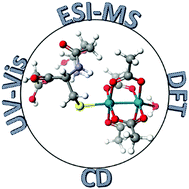Glutathione binding to dirhodium tetraacetate: a spectroscopic, mass spectral and computational study of an anti-tumour compound†
Abstract
Glutathione (γ-L-glutamyl-L-cysteinyl-glycine) is a ubiquitous tripeptide found in all plants and animals. Glutathione has key roles as a metallochaperone and as a cellular thiol involved in metabolism. Little is known about how glutathione interacts with organometallic compounds in vivo. Here, we report the reactions of glutathione in vitro with dirhodium(II) tetraacetate (tetrakis(μ-acetato)dirhodium(II), Rh2(OAc)4), a compound with anti-tumour properties. Electrospray ionization mass spectrometry, UV-Visible absorption and circular dichroism spectroscopic methods were used to determine the stoichiometries and optical properties of the final conjugate. Computational analyses were used to predict the binding modes of glutathione to the Rh2(OAc)4, and report on the orbital assignments for the resulting products. We explored the competition by GSH for methionine-bound axial sites on Rh2(OAc)4 to investigate the use of weak thioether to protect its cellular-based anti-cancer activity. Our study highlights the important role that axial ligation would play in deactivating or significantly decreasing the efficacy of this bimetallic anti-tumor drug. The computational data explain the stability of the mono-adduct and the appearance of new absorption bands in the UV region including retention of the Rh–Rh single bond. Additionally, these data show that glutathione can effectively disable the potency of these metallo-drugs through orbital overlap of the entire Rh–Rh core as a result of the strong binding. Electronic absorption spectroscopy, mass spectrometry and computational analysis are a powerful combination in understanding possible chemical reactions in vivo and this information can be used to synthetically tune dirhodium complexes for use in the fight against cancer.



 Please wait while we load your content...
Please wait while we load your content...